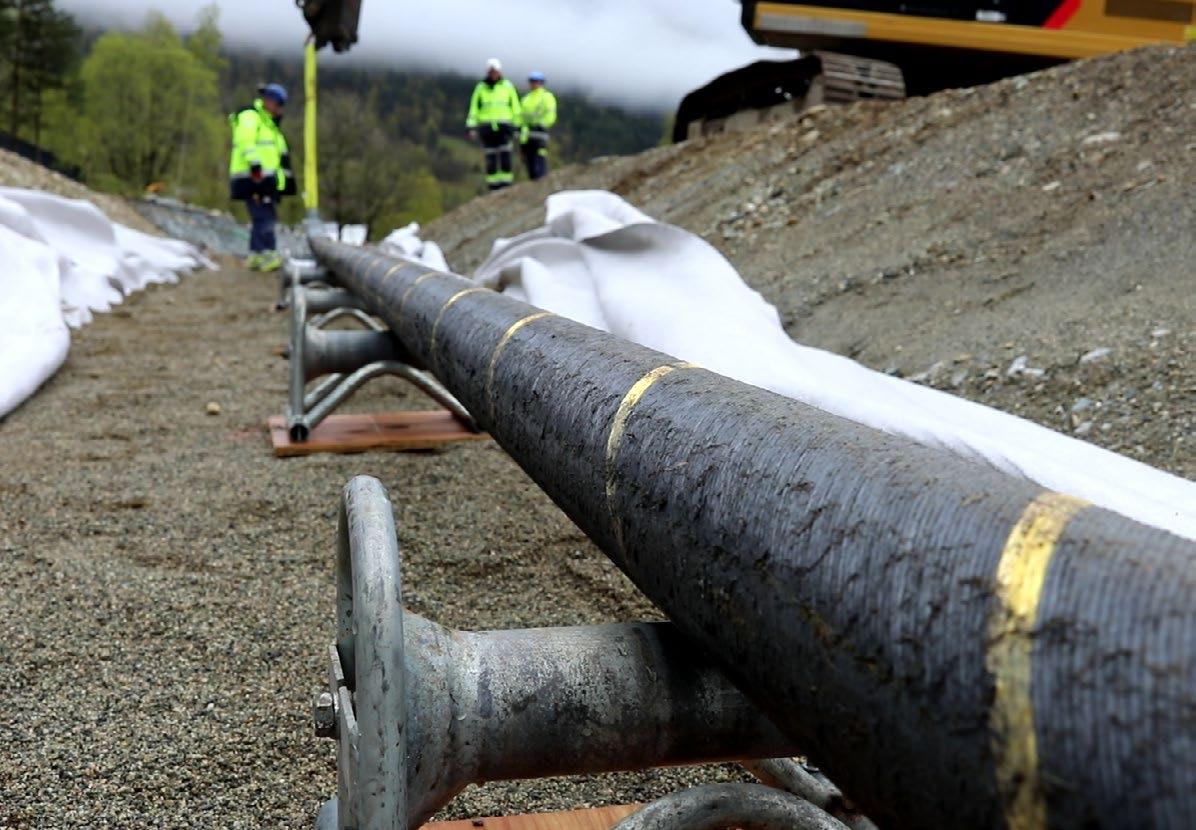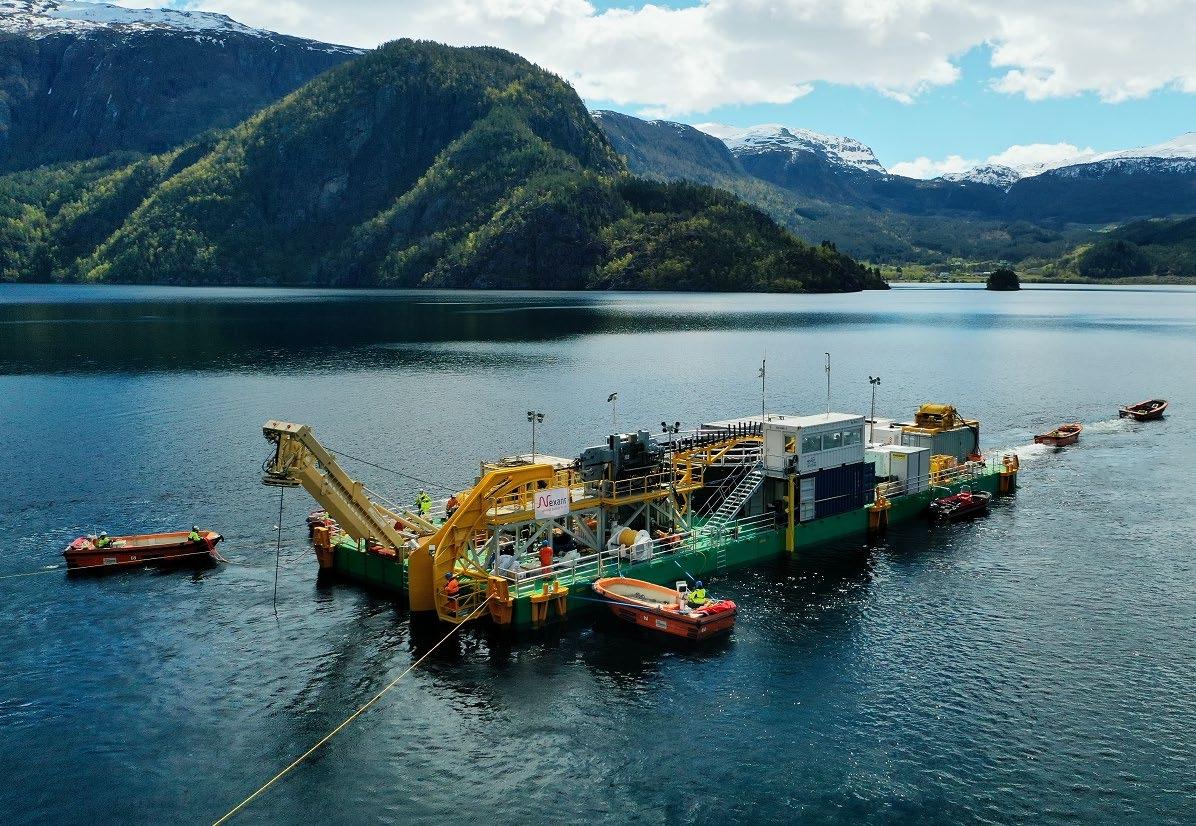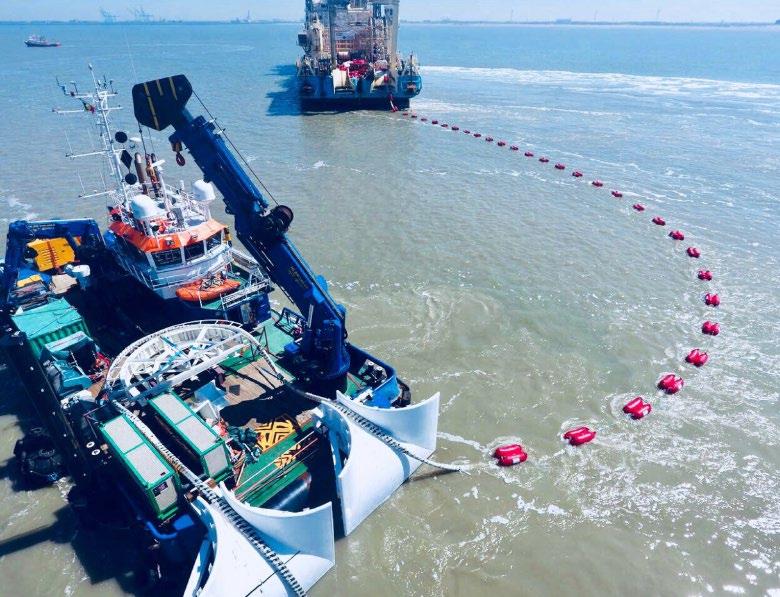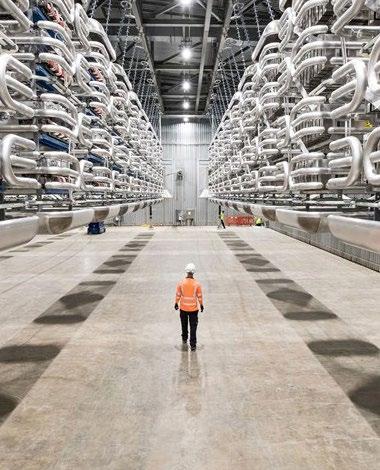
11 minute read
National Grid Ventures –Transforming Energy
involved in some large scale, complex stuff.
In terms of the team itself, we have a team of around forty, with eight of those being my leadership team in addition to category leads who each have their own category ownership or project specific responsibilities.
Advertisement
We have a blend of both category management teams (who are accountable for setting the category strategy for our core category areas such as; HVDC cable, convertor stations and Liquid Natural Gas (LNG equipment))and then our project specific procurement teams, who will execute these strategies for some of our biggest project procurements, with some of the biggest HVDC projects costing in excess of a billion pounds to build and around 18 months to deliver.
Owing to the strong experience my team have in the (HVDC) category, we have recently started supporting the Electricity Transmission business on a growing HVDC offshore asset portfolio. This is great as it allows us to apply our category knowledge to a new and growing spend base.

In addition to my core responsibilities, I also sponsor our procurement people strategy within the UK and own the National Grid relationship with CIPS which is a key focus area for us to ensure our people continue to get the right opportunities to continue to progress with their development.
National Grid Ventures is the competitive division of National Grid, operating outside of the core regulated part of the business (such as Electricity Transmission and Electricity Distribution).
NGV develops, operates, and invests in energy projects, technologies, and partnerships to accelerate the development of a clean energy future. With a diverse portfolio of low carbon and renewable energy assets across the UK, Europe and US, NGV is pushing the boundaries of a new energy horizon.
Kristian Hollowood, NGV’s Head Of Procurement provides the details and explains why NGV is a great place if you want to have a hand in making a multigenerational difference.
Hi Kristian, please offer a snapshot of your role and responsibilities.
I lead the procurement function that support National Grid Ventures (NGV) and the High Voltage Direct Current (HVDC) portfolio across National Grid Group. I report into the Director of UK Procurement who then reports into our CPO.
This includes understanding the key priorities within NGV and then setting the strategic direction for our team, enabling the team to deliver the key outcomes we’ve committed to our stakeholders through implementing our category management principles. We’re working on a significant level of expenditure across a range of asset classes, business units and stakeholder groups, so plenty of opportunity to get
National Grid Ventures operates a broad mix of energy assets and businesses in the UK and US. With many activities bordering and crossing between regulated and non regulated. What complexity does this mix of geography, variety of assets, and regulation add to the procurement function?
Well, it can make it a little more complex. The NGV business is a little different to the core business as you’ve rightly pointed out, often wanting to work at pace and with a degree of uncertainty that a new venture will come to fruition, but that’s what makes this role interesting and varied. I’ve got a great leadership team who really know their stuff which becomes extremely useful when trying to pick up some of the technical intricacies of each category area.
In regard to regulation, that’s fairly straight forward for us in procurement as we try to apply a common set of best practice principles to both category management and strategic sourcing regardless of how category spend is regulated (or not) and whether utilities procurement regulations apply. However, there is a perception that regulated procurement processes can be overly complex so it’s still important to think laterally and be agile in our approach wherever we can be. Funding mechanisms also vary meaning our Category strategies will need to consider how each funding mechanism works and whether that limits our options (such as an inability to commit to suppliers post final investment decision) or provides further opportunity (like leveraging multi-year portfolio commitments). In some cases, we engage with OFGEM around what is happening in the supply chain with a view to amending the way we’re funded if we think it will provide us with additional strategies that will benefit the end consumer. has already imported enough green energy to offset the carbon cost of construction.

It’s important that my team can understand all of the various business drivers at play within the business units we work with and assimilate those insights to create coherant category strategies that utilitise our category management principles and exhaust a full range of value levers in order to deliver value for the organisation..
Interconnectors are enabling the UK to connect to Europe and drive towards a net zero future. With an estimation that 90% of all energy via the interconnectors by 2030 will be from zero carbon sources the ongoing expansion of the interconnector network is key to National Grid and the UK’s goals. The latest Interconnector – North Sea Link has just come online. Connecting the UK to Norway is a significant feat, this six-year project is a great example of partnership and collaboration. It is also a great example of the role procurement plays in driving complex projects. Can you offer an insight into this project and why procurement had the seat at the table from day one?
NSL is certainly a project the NGV Team is really proud of, currently the longest subsea Interconnector in the world, powering 1.4m homes, which after six months in operation has already imported enough green energy to offset the carbon cost of construction.

As you will appreciate, building a new Interconnector takes time, approximately six years from start to finish when considering the Business Case, Planning, Consenting, Surveys, Design, EPC Procurement, Construction, and all being well, Operations. Therefore, the procurement for NSL was delivered a number of years before my time so unfortunately, I can’t take any of the credit for all the hard work the Procurement team put in, however what I can say is, all of our Interconnectors in NGV and HVDC links in the ET business are in collaboration with JV partners and therefore the relationship with our partners is essential. Delivering a procurement event of this size and scale requires a number of key ingredients to make it successful; a common purpose and set of clear outcomes, and a team ethic along with a willingness for collaboration when navigating differing opinions along the way!
Timelines for these large scale projects are also imperative and with procurement being one of the largest lead time activities outside of planning, consenting and construction it’s really important procurement lead the sourcing process exceptionally well, introducing the right business skills and expertise from around the organisation throughout the event whilst also engaging with members of the Joint Venture Executive Group at the critical points in time to influence and advise on key decisions and risks.
Procurement also plays a vital role in projects of this scale in regard to bringing insight from the external marketplace into the project, which involves getting out there and seeing suppliers, visiting factories and attending exhibitions in order to get a true picture of what’s really happening. As you will have read, many European Transmission Owners are supporting their own respective government 2030 renewable energy targets which means a change in the supply/ demand dynamics in the HVDC marketplace. This requires procurement to not only identify this in the first place but mitigate the consequential effects of this market change through the category strategies and sourcing strategies we deploy.
As we can see, operating in a business that is primarily focused on mega projects (or projects of significant magnitude) somewhat elevates the role of procurement, allowing early access to the challenge ahead. This is often not the case with many of your procurement peers in other industries. However, the nature and complexity of such projects must mean in most situations that the pool of potential partners (suppliers) is quite small. Does a smaller supply chain result in firmer more collaborative relationships?
You’re right in that our supply chain tends to be a smaller, more niche set of suppliers –particularly in our LNG and HVDC category areas. Focussing on HVDC as a category, there are just over a handful of recognised suppliers for HVDC subsea cable suppliers and onshore converter station suppliers around the world. Previously, projects like this happened every
4/5 years, primarily led by ourselves in the UK or some other transmission owners in Europe. Now owing to multiple governmental net zero targets around Europe and an aspiration to introduce as much renewable offshore wind into our energy system as possible it now means there is an unprecedented demand for this particular equipment. That means that there is an even greater focus on supply chain collaboration going forward; whether that be simply securing factory capacity through longer term strategic relationships, increased transparency and visibility of upcoming demand to enable better planning, working together to standardise specifications or using our key OEM cable and converter suppliers to act as advisors in our early design phases to ensure delivery is executed as efficiently as possible.
In addition to the key suppliers we currently work with, we have also identified emerging suppliers from around the world and will be investing effort in them in the near future to try and improve the resilience in the supply chain.
Sticking with the supplier collaboration theme. The world class Grain LNG facility was the first of its kind by National Grid Ventures. Another significant project in terms of investment and complexity. Did you utilise the expertise of vendors in shaping this project?
Grain LNG facility was initially commissioned in 2005 and can provide up to 25% of the UK’s gas demands, which makes it a critical part of the UK’s energy infrastructure, non-more so than right now consideration current geopolitical events.
The most recent development at Grain, called ‘Capacity 25’ will expand the facility to be able to provide up to 33% of the UKs gas supply with its new 190k m3 LNG Storage tank (the fifth to be built on site) and an increased unloading facility making it the only LNG facility in Europe allowing two ships to unload at any one time.
The decision on the procurement strategy for ‘Capacity 25’ did require a significant amount of market intelligence gathering, particularly as this type of facility hadn’t been built for a number of years and the market had inevitably moved on from the last time we built something similar. During that engagement we spoke to the supply chain to gain insight into what they believed would make both the project and the procurement event appealing to them, this included risk appetite, contract form, scope of the contract and who in the market was best placed to deliver which scopes of work, supply chain risks and bottlenecks (The market at this time was very constrained and suppliers were being particularly selective as to which projects they bid on). This feedback was a key reason for deciding to split out the tank build and the subsequent main site works owing to the appetite of the suppliers to take on such a large project.
We are now into construction phases on the project and since awarding contracts for both our tank and main site works, the teams continue to collaborate through design phases and construction deliverables to ensure the project is delivered in the safest, most efficient way possible.
We have previously stated the complex nature of most projects, but like any construction project whilst there may be a need for the latest technology and equipment there will also be a requirement for more traditional services. From a local content perspective is there a big push to ensure that where possible, contractors and suppliers in the local area (region) are involved in the development phase?
I think it’s really important that the communities we are working in benefit from our presence in the area, whether that is increasing opportunities for SMEs, local suppliers or social enterprises so that the local economy can thrive, driving an uplift in local skills and employment whilst also creating opportunities for disadvantaged people and support social mobility.
National Grid has a responsible business charter which looks at driving an increase in ‘Responsible Business’ measures and we are also pushing this thinking into our Category Strategies to ensure our teams are considering how we can build social value into all our relevant procurement activity,
In regard to local content specifically, we have supplier diversity strategies in place within the US and plan to integrate our community impact strategies within the UK, these all help provide guidance on our ambitions as I’ve mentioned above.
In addition to National Grid driving this because we believe it’s the right thing to give back to the communities we serve, on the regulated side of the business we are starting to see more regulatory requirements to support local content, this is particularly prevalent in the US and is a really key driver for jurisdictions to support upcoming offshore community wind developments in the North East of the US whilst creating local content and jobs for many.
Energy consumption is rising, and the net zero drum becomes louder every day. The energy sector has maybe never had so much exposure. Does this increased awareness reflect in the number of new entrants in the vendor space who are vying to work with National Grid Ventures? What opportunities exist for start-ups and SME’s?
I wouldn’t necessarily say we’ve seen an increase of suppliers that are looking to work with us, however with the challenges National Grid face in regard to delivering the energy transition means we are more reliant on our supply chain than ever, whether that is because of wanting to increase our supply chain resilience, innovating current practices and procedures or looking to secure increased capacity in a constrained marketplace.
Specifically in relation to start ups and innovation, NG Partners is National Grid’s corporate venture capital and disruptive innovation group, which works to nurture and grow innovation inside National Grid while scanning the market for technologies and companies with the potential to disrupt our existing business models.
NG Partners works with all business units and support functions to tackle complex, technology-driven problems and find solutions that make our company more efficient, digital, and entrepreneurial through NG Partners with start-ups, internal innovation projects and cultural acceleration programs. Procurement work with partners wherever possible to identify business opportunities for innovation during our category strategy activity. We’ve also been working on our current procurement procedures and identifying where our barriers to entry for start-ups have been unnecessarily high and therefore worked to simplify them wherever possible to allow pilots and proof of concepts to develop and flourish in collaboration with startups to help resolve some of our common business issues with the creation of new technologies, software or innovations. By making these changes to the way we procure allows us to drive value by accessing markets we’ve not previously been able to access.
Whilst a significant portion of your focus is towards the highly intensive projects there is still a considerable asset base that requires your teams daily attention. Capex is significantly different to Opex in your world. Do you think that this complex mixture is what makes working in procurement at National Grid Ventures so rewarding?

I do think working at National Grid as a whole gives you a great opportunity to experience a range of categories whether that be Construction, Operations and
Maintenance, IT, Indirects and Fleet. I believe it’s also a great time to be working within National Grid as we are at the heart of the energy transition, so this gives you a feeling of greater purpose and pride, working on the development and maintenance of assets that are going to be crucial in the UK having a resilient, sustainable energy network for the future.
Within NGV specifically, having responsibility for the procurement of the whole life cycle of assets we build, means the team have a fantastic opportunity to be exposed to a mix of both large infrastructure construction procurement (which is high profile, complex and often with a JV partner) but ultimately a single tender event, or working in our category

